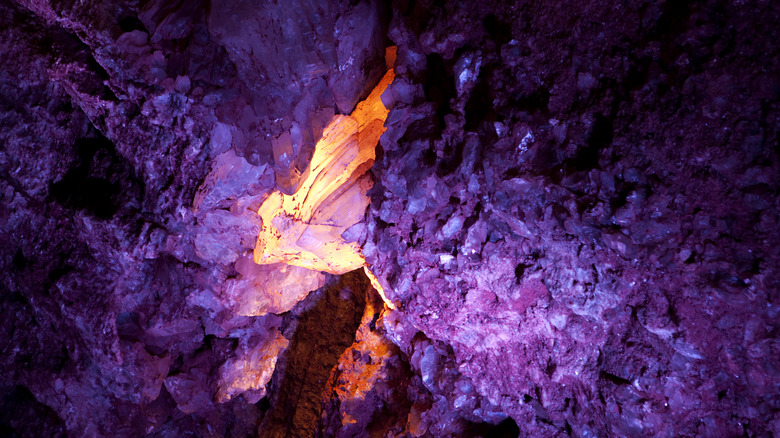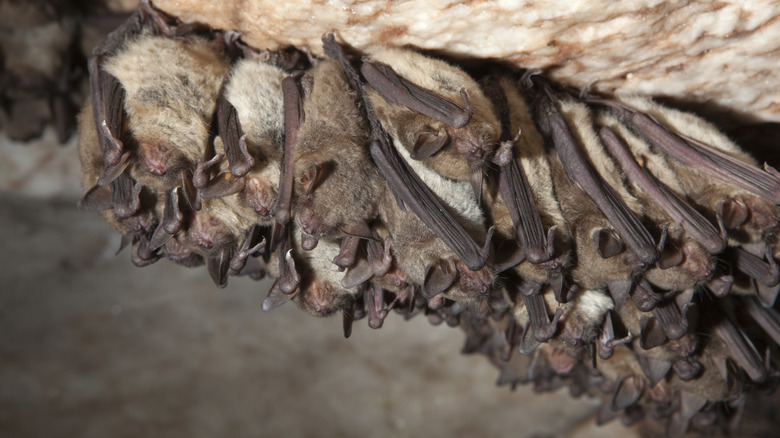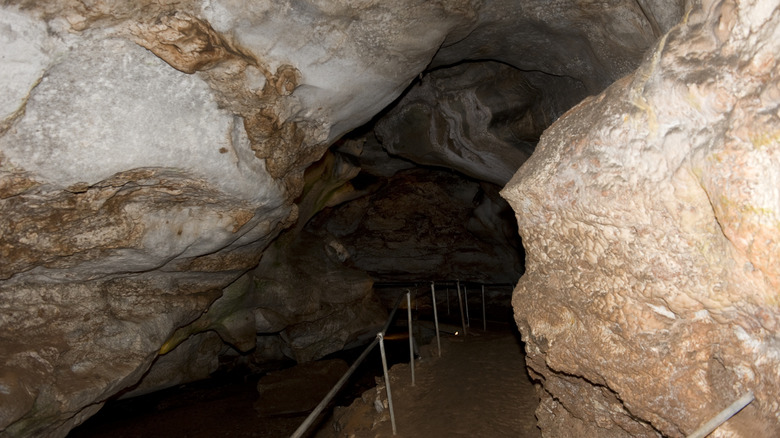Hike Or Go Spelunking At Oklahoma's Underrated State Park With The World's Largest Natural Gypsum Cave
The vast landscape of the United States offers pretty much every type of outdoor attraction under the sun. However, for a certain type of adventurer, below the surface is where the real fun begins. Some of the world's most remarkable cave systems are begging to be explored, from the behemoth Mammoth Cave in Kentucky to the complex geological formations of New Mexico's Carlsbad Caverns. But while these settings are well-recognized in their own national park sites, the U.S. has tons of lesser-known caves that are equally impressive. Fittingly, one of America's most memorable cave systems is tucked away in a little-known state park in Oklahoma.
The Sooner State isn't often recognized for its natural beauty, but it boasts abundant outdoor riches if you know where to look. Oklahoma's Greenleaf State Park features scenic mountain trails, cute cabins, and gorgeous lakeside views, while the Chickasaw National Recreation Area has some of the best outdoor recreation in the South. Still, for anyone who's subterranean at heart, the unsung Alabaster Caverns State Park is Oklahoma's best natural feature.
This park's cave system offers visitors different types of underground adventures, ranging from popular sightseeing tours on well-maintained paths to daring descents into undeveloped cave chambers. But Alabaster Caverns is more than merely a fun underground adventure; it also boasts some of the most unique and notable geological features of any cave in the world.
Alabaster Caverns State Park is a geological marvel — and a haven for bats
The name "Alabaster Caverns" comes from the cave's significant veins of alabaster, a type of mineral and a naturally occurring form of gypsum. Gypsum caves, while rare, are not unheard of, even in the United States. For example, South Dakota's dazzling Jewel Cave National Monument is rich in gypsum crystals. But Alabaster Caverns stands out even among such scintillating competition. Not only is this one of the largest gypsum caves in the world, but its geology is particularly unique relative to other similar cave systems.
Alabaster Caverns State Park contains several different kinds of naturally occurring alabaster, including a rare type called "black alabaster" that's not often found even in other gypsum caves. Many of the cave's gypsum deposits have long-ago formed into complex, gorgeous crystals known as selenites, which decorate the cave walls in magical displays of nature's craftsmanship.
As impressive as its geology is, Alabaster Caverns State Park is even more than just fancy rocks. For animal lovers, the cave is also home to massive populations of five different species of bat. Bats aren't exactly the most popular of the world's animal species, and many people would probably rather not run into one. But these cave-dwellers are actually critically important to the environment aboveground (particularly for their valuable and unappreciated public service of eating large numbers of annoying insects), and the complex ecosystem forged by the cave's bat population is a wonder to behold no matter your feelings on bats themselves.
When you venture into the cave today, you have a good chance of seeing these amazing creatures hanging from the rocky ceiling, especially during their hibernation period between December and March.
The best ways to experience Alabaster Caverns State Park
America's most popular "show caves" usually feature more than one type of experience. For example, Kentucky's Mammoth Cave National Park offers adventures both below and aboveground. Alabaster Caverns State Park is no exception. The cave's main chambers feature well-developed infrastructure that includes walking trails and stairs. Guided tours are offered daily for groups of up to 40 people. The main visitor path is less than a mile long, and includes over 300 stairs. Though you may break a sweat, this section is still doable for most visitors (even kids).
However, unlike many other show caves, Alabaster Caverns also allows for much more daring experiences. For skilled spelunkers, the park offers permits for "wild caving" tours of four undeveloped cave systems. These chambers feature no lights or infrastructure and reach lengths of up to 1,600 feet. With obvious risks, you'll need sufficient gear and experience before attempting the difficult underground terrain. But for all the challenges, these wild caving tours feature a one-of-a-kind adventure into one of the most extraordinary cave systems in the country. (Note that wild caving permits are only available from April 1 to September 30 to protect the cave's bat populations during hibernation season.)
Alabaster Caverns State Park is located near the town of Freedom, OK, about 2.5-hours from Oklahoma City's Will Rogers International Airport. The park's 200 acres include campgrounds and RV sites, plus aboveground hiking trails if you're not keen on leaving the sunlight. But if you do want to descend below the surface, the gypsum wonderland of Alabaster Caverns is a geological marvel you won't ever forget, no matter how you experience it.


